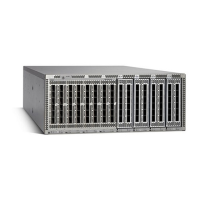Configuring MVR Interfaces
Procedure
PurposeCommand or Action
Enters global configuration mode.switch# configure
terminal
Step 1
Globally enables MVR. The default is disabled.mvr
Step 2
If MVR is enabled globally, then this command is not
required.
Note
Specifies the Layer 2 port to configure, and enters interface
configuration mode.
interface {ethernet type
slot/port | port-channel
Step 3
channel-number |
vethernet number}
If this is a 10G breakout port, the slot/port syntax is
QSFP-module/port.
Note
Configures an MVR port as one of these types of ports:[no] mvr-type {source |
receiver}
Step 4
• source—An uplink port that sends and receives multicast data is
configured as an MVR source. The port automatically becomes
a static receiver of MVR multicast groups. A source port should
be a member of the MVR VLAN.
• receiver— An access port that is connected to a host that wants
to subscribe to an MVR multicast group is configured as an MVR
receiver. A receiver port receives data only when it becomes a
member of the multicast group by using IGMP leave and join
messages.
If you attempt to configure a non-MVR port with MVR characteristics,
the configuration is cached and does not take effect until the port
becomes an MVR port. The default port mode is non-MVR.
(Optional)
Specifies an interface default MVR VLAN that overrides the global
default MVR VLAN for joins received on the interface. The MVR
[no] mvr-vlan vlan-id
Step 5
VLAN is the source of the multicast message that subsequent receivers
subscribe to.
The range is 1 to 4094.
(Optional)
Adds a multicast group at the specified IPv4 address and (optional)
netmask length to the interface MVR VLAN, overriding the global
[no] mvr-group
addr[/mask] [vlan
vlan-id]
Step 6
MVR group configuration. You can repeat this command to add
additional groups to the MVR VLAN
The IP address is entered in the format a.b.c.d/m, where m is the number
of bits in the netmask, from 1 to 31.
Cisco Nexus 6000 Series NX-OS Layer 2 Switching Configuration Guide, Release 7.x
129
Configuring MVR
Configuring MVR Interfaces

